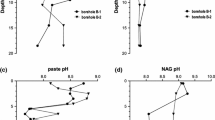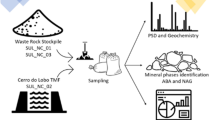Abstract
Cemented layers (hardpans) are common in carbonate or sulphide-rich mine tailings and where pyrrhotite is the predominating Fe-sulphide. Laver, northern Sweden, is an abandoned Cu-mine where the tailings have low pyrrhotite content, almost no pyrite and no carbonates. Two cemented layers at different locations in the Laver tailings impoundment were investigated, with the aim to determine their effects on metal mobility. The cementing agents were mainly jarosite and Fe-oxyhydroxides in the layer formed where the tailings have a barren surface, whereas only Fe-oxyhydroxides were identified below grass-covered tailings surface. Arsenic was enriched in both layers which also exhibit high concentrations of Mo, V, Hg and Pb compared to unoxidised tailings. Sequential extraction indicates that these metals and As were mainly retained with crystalline Fe-oxides, and therefore potentially will be remobilised if the oxic conditions become more reducing, for instance as a result of remediation of the tailings impoundment.





Similar content being viewed by others
References
Agnew M, Taylor GF (2000) Development, cycling and effectiveness of hardpans and cemented layers in tailings storage facilities in Australia. In: Grundon NJ, Bell LC (eds) Australian workshop on acid mine drainage, Townsville, pp 157–169
Ahmed SM (1995) Chemistry of pyrrhotite hardpan formation. In: C. research scientist, Mineral sciences Laboratories, The department of Natural Resources (eds) Conference on mining and the environment, Sudbury, pp 171–180
Balistrieri LS, Murray JW (1982) The adsorption of Cu, Pb, Zn and Cd on goethite from major ion seawater. Geochem Cosmochim Acta 46:1253–1265
Banwart SA, Malmström ME (2001) Hydrochemical modelling for preliminary assessment of minewater pollution. J Geochem Explor 74:73–97
Bigham JM (1994) Mineralogy of ochre deposits formed by sulfide oxidation. Short course handbook on environmental geochemistry of sulfide mine-wastes. Mineralogical association of Canada, Waterloo
Bigham JM, Nordstrom DK (2000) Iron and aluminium hydroxysulfates from acid sulfate waters. In: Alpers Cn, Jambor JL, Nordstrom DK (eds) Sulfate minerals, crystallography, geochemistry, and environmental significance. Reviews in mineralogy & geochemistry. Mineralogical society of America, Washington, pp 608
Blowes DW, Jambor JL, Appleyard EC, Reardon EJ, Cherry JA (1992) Temporal observations of the geochemistry and mineralogy of a sulfide-rich mine-tailings impoundment, Heath Steele mines, New Brunswick. Explor Mining Geol 1:251–264
Borggaard OK, Elbering B (2003) Biogeochemistry in a pedological context. Holte Bogtrykkeri A/S, Holte, Denmark
Bowell RJ (1994). Sorption of arsenic by iron oxides and oxyhydroxides in soils. Appl Geochem 9:279–286
Chao TT, Sanzolone RF (1977). Chemical dissolution of sulfide minerals. J Res US Geol 5(4):409–412
Courtin-Nomade A, Bril H, Neel C, Lenain J-F (2003) Arsenic in iron cements developed within tailings of a former metalliferous mine-Enguiales, Aveyron, France. Appl Geochem 18(3):395–408
Dold B (2001) Element cycling and secondary mineralogy in porphyry copper tailings as a funtion of climate, primary mineralogy and mineralogy processing. J Geochem Explor 74:3–55
Dold B (2003) Speciation of the most soluble phases in a sequential extraction procedure adapted for geochemical studies of copper sulfide mine waste. J Geochem Explor 80:55–68
Dold B, Fontbote L (2001) Element cycling and secondary mineralogy in porphyry copper tailings as a function of climate, primary mineralogy, and mineral processing. J Geochem Explor 74:3–55
Dzombak DA, Morel FMM (1990) Surface complexation modeling; hydrous ferric oxides. Wiley, NewYork
Hall GEM, Vaive JE, Beer R, Hoashi M (1996) Selective leaches revisited, with emphasis on the amorphous Fe oxyhydroxide phase extraction. J Geochem Explor 56:59–78
Herbert RB (1996) Metal retention by iron oxide precipitation from acidic ground water in Dalrna, Sweden. Appl Geochem 11:229–235
Holmström H, Ljungberg J, Ekström M, Öhlander B (1999) Secondary copper enrichment in tailings at the Laver mine, Northern Sweden. Environ Geol 38:327–342
Jambor JL (ed) (2003) Mine-waste mineralogy and mineralogy perspectives of acid-base accounting. Environmental aspects of mine wastes, 31. Mineralogical Association of Canada, Vancouver, British Columbia, pp 430
Johnson RH, Blowes DW, Robertson WD, Jambor JL (2000) The hydrogeochemistry of the Nickel Rim mine tailings impoundment, Sudbury, Ontario. J Contaminant Hydrol 42:49–80
Kooner ZS (1993) Comparative study of adsorption behavior of copper, lead, and zink onto goethite in aqueous systems. Environ Geol 21:242–250
Lin Z (1997) Geochemical and mineralogical studies of sulfidic wastes in central Sweden. Doctor of philosophy in Environmental Geology Thesis Earth science, Quaternary geology, Uppsala University, Uppsala
Ljungberg J, Öhlander B (2001) The geochemical dynamics of oxidising mine tailings at Laver, northern Sweden. J Geochem Explor 74:57–72
Malmström M, Banwart SA (1997) Biotite dissolution at 25 C: the pH dependence of dissolution rate and stoichiometry. Geochem Cosmochim Acta 61(14):2779–2799
McGregor RG, Blowes DW, Jambor JL, Robertson WD (1998) The solid-phase controls on the mobility of heavy metals at the Copper Cliff tailings area, Sudbury, Ontario; Canada. J Contam Hydrol 33:247–271
McGregor RG, Blowes DW (2002) The physical, chemical and mineralogical properties of three cemented layers within sulfide-bearing mine tailings. J Geochem Explor 76:195–207
McSweeney K, Madison FW (1988) Formation of a cemented subsurface horizon in sulfidic minewaste. J Environ Qual 17(2):256–262
Petersson C, Håkansson K, Karlsson S, Allard B (1993) Metal speciation in a humic surface water system polluted by acidic leachates from a mine deposit in Sweden. Water Res 27(5):863–871
Ribet I, Ptacek CJ, Blowes DW, Jambor JL (1995) The potential for metal release by reductive dissolution of weathered mine tailings. J Contam Hydrol 17:239–273
Stumm W, Morgan JJ (1996) Aquatic chemistry, chemical equilibria and rates in natural waters.Wiley, NewYork
Thurman EM (1985) Organic geochemistry of natural waters. Martinus Nijhoff/Dr W. Junk Publishers, Dordrecht
Tipping E, Cooke D (1982) The effects of adsorbed humic substances on the surface charge of goethite (a-FeOOH) in freshwater. Geochem Cosmochim Acta 46:75–80
Ödman OH (1943) Geology of the copper deposits at Laver. SGU (Geological Survey of Sweden) C 452:1–35
Acknowledgements
We want to thank Dr. Erik Carlsson for his support and helpful discussions and Fredrik Jarleman, Olov Öhman, at the Department of Chemistry and Metallurgy at Luleå University of Technology, for their support when carrying out the XRD, SEM and EDS analyses. The ICP analyses were performed by Analytica AB in Luleå. Milan Vnuk prepared the figures. Special thanks to Birgitta Nyberg for her support in the laboratory. This research was financed by PIRAMID (Passive In-situ Remediation-Acid-Mine-Industrial-Drainage) and Luleå University of Technology.
Author information
Authors and Affiliations
Corresponding author
Additional information
An erratum to this article can be found at http://dx.doi.org/10.1007/s00254-006-0376-0
Rights and permissions
About this article
Cite this article
Alakangas, L., Öhlander, B. Formation and composition of cemented layers in low-sulphide mine tailings, Laver, northern Sweden. Environ Geol 50, 809–819 (2006). https://doi.org/10.1007/s00254-006-0253-x
Received:
Accepted:
Published:
Issue Date:
DOI: https://doi.org/10.1007/s00254-006-0253-x




